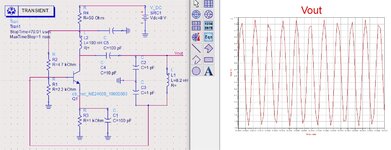mirkata0
Newbie level 4

Hello everyone,
I am really struggling with designing a Colpitts oscillator for 2.4 Ghz. I know the principles and read a lot about it but my simulation in ADS does not work. I am spending hours on this without any progress and can't find where is my mistake. Would really appreciate if someone can give me advice on what I should do? Here is the circuit which I have designed. (and yeah i know that my bypass capacitor is not connected).

I am really struggling with designing a Colpitts oscillator for 2.4 Ghz. I know the principles and read a lot about it but my simulation in ADS does not work. I am spending hours on this without any progress and can't find where is my mistake. Would really appreciate if someone can give me advice on what I should do? Here is the circuit which I have designed. (and yeah i know that my bypass capacitor is not connected).



